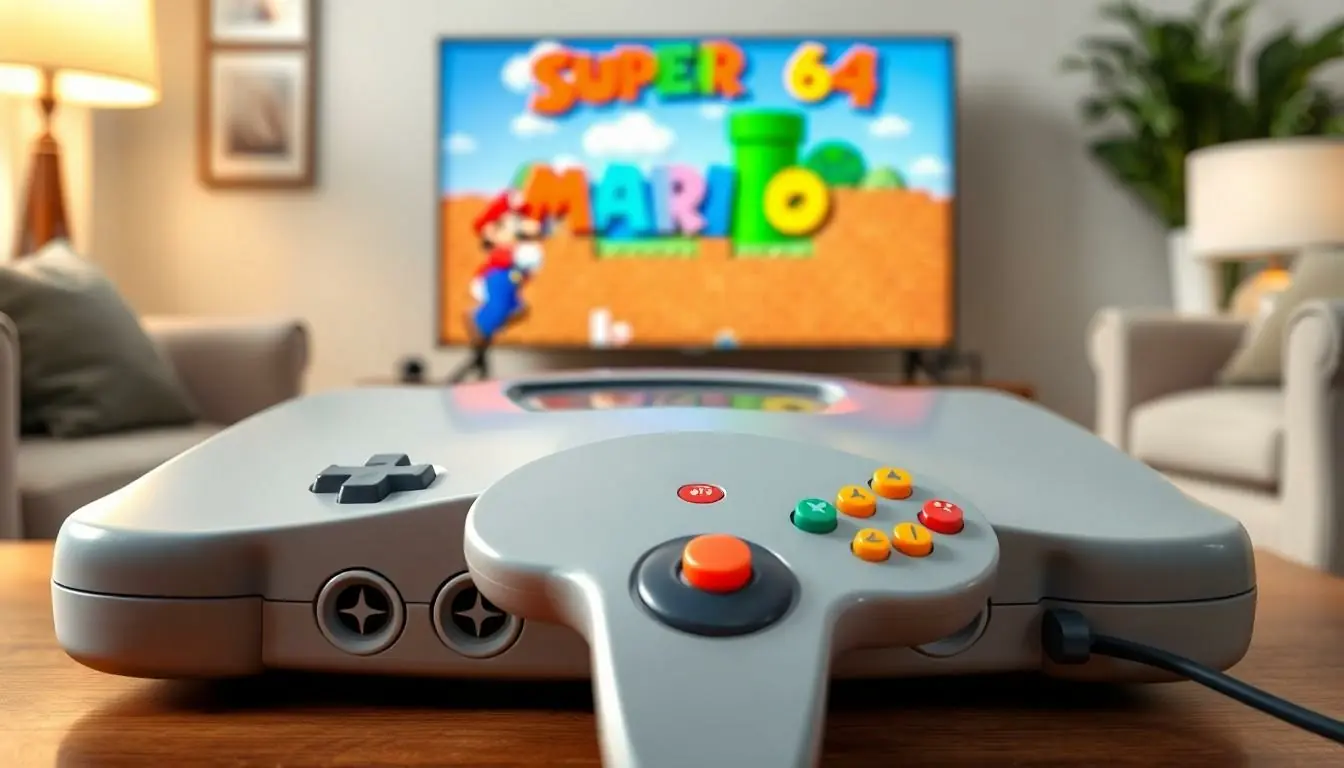Table of Contents
ToggleIn the mid-90s, the gaming world was about to get a serious upgrade. Enter the Nintendo 64, a console that promised to take players on a wild ride through vibrant 3D worlds. With its iconic controller and groundbreaking graphics, it quickly became the must-have gadget for every kid—and adult—who dared to dream of conquering the Mushroom Kingdom or racing on Rainbow Road.
Overview of Nintendo 64 Release
Nintendo 64, released in June 1996, marked a significant evolution in gaming technology. It introduced advanced graphics that provided players with a more immersive environment. Through 3D design, titles like “Super Mario 64” and “The Legend of Zelda: Ocarina of Time” became benchmarks for future game development.
Unique features enhanced the gaming experience. The innovative controller, featuring an ergonomic design and an analog stick, allowed for precise movements in virtual spaces. Multiplayer functionalities encouraged social gaming, with titles supporting up to four players.
Game selection played a vital role in the console’s popularity. Launch titles included high-profile games that captivated audiences. Over 300 games were released over the console’s lifespan, providing diverse genres and experiences.
Market reception proved positive. Nintendo 64 sold over 32 million units worldwide, solidifying its position among the top-selling consoles of the era. Its legacy continues to influence modern gaming, demonstrating that groundbreaking technology can shape player expectations.
In the competitive landscape of the 90s, Nintendo positioned itself strategically against rivals like Sony’s PlayStation and Sega’s Saturn. The distinct 64-bit architecture differentiated it from competitors, catering to gamers seeking richer graphics and gameplay depth.
Through innovation and a robust library, Nintendo 64 became a staple in homes, providing unforgettable gaming experiences for generations. Its impact on the industry persists, making it a memorable chapter in gaming history.
Key Features of Nintendo 64
The Nintendo 64 introduced several groundbreaking features that set it apart in the gaming landscape. Its advancements in graphics and innovative controller design significantly influenced player engagement.
Powerful Graphics and Sound
Graphics and sound capabilities marked a major leap for the Nintendo 64. The console utilized a 64-bit architecture, which delivered enhanced visual experiences. Players enjoyed detailed 3D environments, bringing games like “Super Mario 64” and “The Legend of Zelda: Ocarina of Time” to life. High-quality audio complemented these visuals, creating an immersive atmosphere that heightened gameplay. With support for up to four simultaneous players, the console’s graphics and sound harmonized to elevate multiplayer experiences, truly redefining gaming standards in the late 90s.
Innovative Controller Design
The Nintendo 64 controller featured a unique tri-handle design, which revolutionized user interaction. An analog stick enabled fluid movement and precise control that suited diverse game genres. It also included a built-in rumble feature, providing players with tactile feedback during gameplay. Functionality extended further with multiple trigger buttons, accommodating complex game mechanics. This ergonomic controller design enhanced comfort for long gaming sessions, catering to the needs of both casual and competitive players alike. Such innovations created a new benchmark for controller design, influencing future gaming peripherals.
Impact on Gaming Culture
The Nintendo 64 significantly shaped gaming culture and established new norms in the industry. It introduced groundbreaking features that resonated with gamers.
Popularity and Market Reception
Upon its release, the Nintendo 64 quickly gained traction among players. Sales reached over 32 million units globally, making it one of the best-selling consoles of its time. Critics praised its innovative technology and compelling game library, which included iconic titles like “Super Mario 64” and “The Legend of Zelda: Ocarina of Time.” These games not only set new standards but also attracted casual and hardcore gamers alike. The multiplayer capabilities engaged friends and families, promoting a social gaming phenomena. Its success led to a solid fanbase that would remain loyal for years.
Influence on Future Consoles
The impact of the Nintendo 64 extended beyond its lifecycle, influencing later consoles. Design elements, such as the analog stick and ergonomic controller shape, became industry standards. Game mechanics introduced during this era, like 3D exploration and open-world environments, shaped future titles. Following its legacy, manufacturers adopted its architecture principles to enhance graphics and gameplay depth. The innovative approach to multiplayer gaming inspired future platforms to prioritize social interaction. Overall, the Nintendo 64 laid essential groundwork that continued to evolve in subsequent generations.
Notable Game Titles at Launch
The Nintendo 64 had an impressive lineup of game titles at launch that showcased its technological capabilities. Two standout titles, “Super Mario 64” and “The Legend of Zelda: Ocarina of Time,” defined a generation of gaming.
Super Mario 64
“Super Mario 64” revolutionized platform gaming with its 3D environment. Players controlled Mario as he navigated various worlds to rescue Princess Peach. Its innovative use of analog control for movement enhanced gameplay, creating a fluid experience. Collecting power stars in different levels established a new standard for open-world exploration. Critics lauded the game’s design, which influenced future platformers significantly. By prioritizing exploration and player freedom, “Super Mario 64” became a benchmark for all action-adventure games thereafter.
The Legend of Zelda: Ocarina of Time
“The Legend of Zelda: Ocarina of Time” captivated audiences with its rich storytelling and immersive gameplay. Following Link’s quest to thwart Ganondorf, players cherished the blend of puzzle-solving and combat. Utilizing real-time battles set a new precedent for action RPGs. The game’s day-night cycle and vast world design showcased the console’s capabilities, drawing players into its detailed environment. Many hailed it as one of the greatest games of all time, solidifying its legacy in the gaming community. “Ocarina of Time” introduced concepts that would inspire countless sequels and spin-offs, reinforcing its iconic status.
Conclusion
The Nintendo 64’s release marked a pivotal moment in gaming history. Its advanced technology and iconic titles not only redefined player experiences but also set new standards for future consoles. The console’s legacy endures through its innovative design and memorable games, continuing to influence the industry today. As gamers reflect on their experiences, the impact of the Nintendo 64 remains evident in modern gaming culture. Its contribution to multiplayer gaming and 3D exploration has left an indelible mark, ensuring that its significance will never be forgotten.





